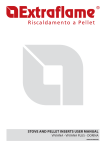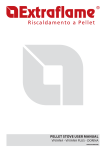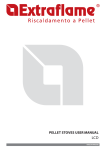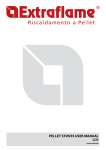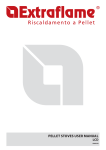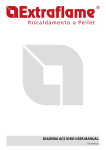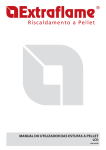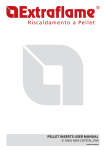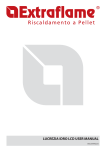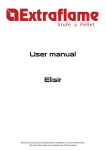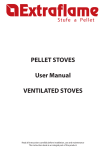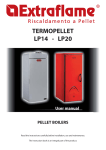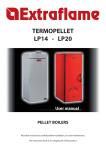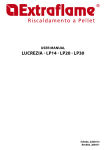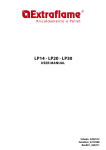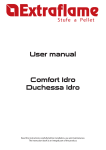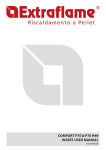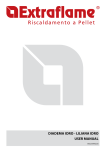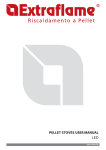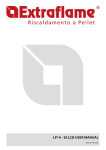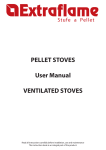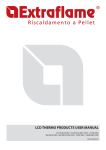Download Rev004_280411_2272575 STOVE AND PELLET INSERTS USER
Transcript
STOVE AND PELLET INSERTS USER MANUAL UK FI NO EE RU SE LV DK LP IE NL BY UK PL BE DE UA LU CZ SK FR MD AT CH HU SI RO HR BA YU BG PT IT ES MK AD AL GR Rev004_280411_2272575 2 ENGLISH ............................................................... 4 1. 2. 3. 4. WARNINGS ..............................................................4 SAFETY .....................................................................4 SAFETY DEVICES....................................................5 INSTALLATION........................................................5 4.1. INSTALLATIONS ALLOWED ..........................................................6 4.2. INSTALLATIONS NOT ALLOWED...............................................6 4.3. CONNECTION TO THE SMOKE EVACUATION SYSTEM .6 4.3.1. SMOKE CHANNEL OR FITTINGS ...............................6 4.3.2. CHIMNEY OR INDIVIDUAL FLUE ...............................7 4.3.3. CHIMNEY CAP.....................................................................8 4.4. CONNECTION TO EXTERNAL AIR INLETS ............................8 4.5. INSULATION, FINISHINGS, COVERING AND SAFETY RECOMMENDATIONS .................................................................................9 4.6. NATIONAL, REGIONAL, PROVINCIAL AND TOWN COUNCIL REGULATIONS ...........................................................................9 THERMOSTAT (AS PER STANDARD) ...............20 12.4.3.2. STBY WITH ADDITIONAL EXTERNAL THERMOSTAT ..........................................................21 12.4.3.3. HOW TO ACTIVATE OR DEACTIVATE STAND - BY ...............................................................21 12.4.4.KEYS LOCKED ...................................................................21 12.4.5.V2 - FAN ...............................................................................21 12.4.6.ENABLE V2 .........................................................................21 13. CLEANING THE UTILITY ..................................... 23 14. CLEANING OF THE “T” FITTING FOR ELISIR ... 24 15. TECHNICIAN YEARLY CLEANING ..................... 25 16. DISPLAYS .............................................................. 26 17. ALARMS ................................................................ 27 18. WARRANTY CONDITIONS ................................ 28 5. INSERTS INSTALLATION .......................................9 5.1. 5.2. 5.3. 5.4. 5.5. 5.6. INSERT COMPARTMENT MINIMUM MEASUREMENTS 9 AIR INLETS...........................................................................................10 AIR CIRCULATION PIPES .............................................................10 STANDARD ASSEMBLY ................................................................11 FRAMES ASSEMBLY (EXCLUDING MODEL P80)............11 INSERT EXTRACTION ....................................................................12 6. HOT AIR DUCTING .............................................. 12 6.1. 6.2. 6.3. 6.4. TOSCA PLUS - EMMA PLUS .......................................................12 ELISIR......................................................................................................12 COMFORT PLUS...............................................................................12 GRAZIOSA STEEL/LUX PLUS.....................................................13 7. PELLETS AND FEEDING ..................................... 13 8. PRODUCT FUNCTIONALITY ............................. 14 8.1. CONTROL BOARD...........................................................................14 8.2. DISPLAY ICONS KEY.......................................................................14 9. FUNCTIONING CYCLE ........................................ 15 9.1. BASIC INSTRUCTIONS ..................................................................15 9.2. IGNITION..............................................................................................15 9.3. WORK.....................................................................................................15 10. ADDITIONAL THERMOSTAT ............................. 16 10.1. STOVE FUNCTIONING WITH ADDITIONAL EXTERNAL THERMOSTAT (OPTIONAL) ...................................................................16 10.2. INSTALLATION .................................................................................16 10.3. ADDITIONAL THERMOSTAT FUNCTIONING FOR DUCTING MOTOR CONTROL...............................................................16 11. THE REMOTE CONTROL ..................................... 16 11.1. REPLACING THE BATTERIES......................................................16 12. SETTINGS MENU ................................................. 17 12.1. SET CLOCK ..........................................................................................17 12.2. CHRONO ..............................................................................................18 12.2.1.RECOMMENDATIONS ..................................................18 12.2.2.PROGRAMMING EXAMPLE.......................................18 12.2.3.CHRONO MENU TABLE ..............................................19 12.3. LANGUAGE .........................................................................................20 12.4. USER .......................................................................................................20 12.4.1.DISPLAY ...............................................................................20 12.4.2.PELLETS ...............................................................................20 12.4.3.STAND - BY.........................................................................20 12.4.3.1. STAND - BY WITH DIGITAL 3 1. WARNINGS Installation must be carried out by qualified staff and/or manufacturer technical assistance, who must provide the buyer with a declaration of conformity for the system and will assume full responsibility for final installation and as a consequence the correct functioning of the installed product. It is necessary to bear in mind all laws and national, regional, provincial and town council Standards present in the country the appliance has been installed. The manufacturer cannot be held responsible for the failure to comply with such precautions. 1. Electric connections: it is therefore recommended that after any intervention on the product, that authorised staff pay particular attention to the electric connections, especially the stripped parts of the wires. These must not escape from the terminal board in any situation, thus preventing possible contact with the live parts of the wire. 2. Type of use: this stove must be destined for the use for which it has been expressly realised. 3. Liability of the manufacturer: The manufacturer is exempt from any liability, contractual and extracontractual, for injury/ damage caused to persons/animals and objects, due to installation, adjustment and maintenance errors and improper use. 4. Check integrity of the product: After the packaging has been removed, check the integrity and completeness of the contents. If this does not comply, contact the dealer where the appliance was purchased. 5. Electric connections: All electric components that make up the stove must be replaced with original spare parts exclusively by an authorised after-sales centre, thus guaranteeing correct functioning. 6. Maintenance:The stove must be serviced at least once a year, programming it in advance with qualified staff and/or the manufacturer's technical after-sales assistance. Nota bene: In case of thermo product or boiler, the product or system venting is not covered by the warranty. The power supply plug must be accessible after installation. Do not close or reduce the dimensions of the airing vents in the place of installation. The airing vents are indispensable for correct combustion. Do not leave the packaging elements within reach of children or unassisted disabled persons. The hearth door must always be closed during normal functioning of the product. When the appliance is functioning and hot to the touch, especially all external surfaces, attention must be paid Check for the presence of any obstructions before switching the appliance on following a prolonged standstill period. The stove has been designed to function in any climatic condition (also critical). In particularly adverse conditions (strong wind, freezing) safety systems may intervene that switch the stove off. If this occurs, contact the technical after-sales service and always disable the safety system. If the flue should catch fire, be equipped with suitable systems for suffocating the flames or request help from the fire service. This appliance must not be used to burn waste Do not use any inflammable liquids for ignition During the filling phase do not allow the bag of pellets to come into contact with the product The majolicas are top quality artisan products and as such can have micro-dots, crackles and chromatic imperfections. These features highlight their valuable nature. Due to their different dilation coefficient, enamel and majolica produce crackling, which demonstrate their effective authenticity. To clean the majolicas, it is recommended to use a soft, dry cloth. If a detergent or liquid is used, the latter could penetrate inside the crackles, highlighting the same. 2. SAFETY For safety reasons, remember that: The stove must not be used by persons (including children) with reduced physical, sensorial and mental capacities or who are unskilled persons, unless they are supervised and trained regarding use of the appliance by a person responsible for their safety. Children must be controlled to ensure that they do not play with the appliance. Do not touch the stove when you are barefoot or when parts of the body are wet or humid. The safety and adjustment devices must not be modified without the authorisation or indications of the manufacturer. Do not pull, disconnect, twist electric cables leaving the stove, even if disconnected from the electric power supply mains. It is advised to position the power supply cable in a way that it does not come into contact with hot parts of the appliance. 4 WARNINGS Heat generator which opening is only allowed through the loading of the fuel during use. SAFETY DEVICES Key: * = present, - = not present BIOMASS Biological material, excluding the material incorporated in geological formations and transformed into fossils. STOVES INSERTS 3. SAFETY DEVICES Circuit board: intervenes directly by sending the product into alarm conditions until complete cooling, in the case * of: breakage of flue gas motor, pellet feed motor breakage, black out (if more than 10 seconds), no ignition * - * INSULATION Group of set-ups and materials used to prevent the transmission of heat through a wall that separates rooms with different temperatures. * * * * CHIMNEY CAP Device positioned at chimney peak to ease the dispersion of combustion products into the atmosphere. * * CONDENSATE Liquid products which form when the fuel gas temperature is lower or equal to the water dew point. * HEAT GENERATORS Appliance which allows to produce thermal energy (heat) through the rapid transformation, through combustion, of the chemical energy of the same fuel. Mechanical air pressure switch: blocks the pellets in the event of insufficient depression (in the models where * envisioned) * 4. INSTALLATION The installation must be in compliance with: UNI 10683 (2005) heat generators fed with wood and other solid fuels: installation. The chimneys must be in compliance with: UNI 9731 (1990) chimneys: classification based on thermal resistance. EN 13384-1 (2006) Thermal and fluid dynamic calculation methods. UNI 7129 point 4.3.3 Fire Department dispositions, local rules and prescriptions. UNI 1443 (2005) chimneys: general requisites. UNI 1457 (2004) chimneys: clay/ceramic flue liners. CLOSED HEARTH APPLIANCE SAFETY DEVICES GATE VALVE Mechanism for modifying the combustion gas dynamic resistance. COMBUSTION PRODUCT EVACUATION SYSTEMS Flue gas exhaust system independent from the appliance constituted by a fitting or smoke channel, chimney or individual flue and chimney cap. FORCED DRAUGHT Air circulation by means of the fan activated by electric motor. NATURAL DRAUGHT Draught which determines in a chimney/flue due to effect of the volume mass difference existing between smoke (hot) and surrounding atmosphere air, without any mechanical intake aid installed inside it or at its peak. RADIATION AREA Area immediately near the hearth in which the heat caused by combustion is diffused, where there must be no combustion materials . REFLUX AREA Area where leaking of the fuel products is verified, from the 5 ENGLISH _ Pellet feed-box temperature control probe: if the tank should overheat, the machine modulates automatically in * order to return to normal temperature values (* in some models) GLOSSARY CHIMNEY Vertical pipe with the aim of collecting and expelling the fuel products coming from only one appliance, at a convenient height from the ground. SMOKE CHANNEL OR FITTING Pipe or connecting element between heat generator appliance and chimney to evacuate fuel products. Upper door micro switch (combustion chamber): if the combustion chamber is opened, the pellet feed motor * functioning is blocked (*in some models) Insert blocking micro switch: if the end run micro switch warns that the insert is not blocked, electric energy does not pass to power it Flow sensor: in the case of inadequate depression, it takes the machine to alarm conditions F2.5 A 250V fuse (stoves): protects the machine from violent current drops 85°C calibrated mechanical bulb with manual rearm: intervenes by blocking fuel feed whenever the pellet tank t° reaches the limit of 85°C. Rearm must be performed by qualified staff and/or the manufacturer's technical after-sales assistance. BIOFUEL Fuel produced directly or indirectly by biomass. appliance towards the installation room. The installation must be preceded by checking the chimneys, flues or unload terminals positioning regarding: Installation prohibitions Legal distances Limitations disposed by local administrative regulations or particular authority prescriptions. Conventional limitations deriving from condominium regulations, constraints or contracts. Insulating product < 45° 4.1. INSTALLATIONS ALLOWED Only appliances working in a sealed manner with respect to the room or which do not place the room in depression with respect to the external environment, can exist or be installed in the room where the heat generator will be installed. Appliances for cooking food and relative hoods without extractor are only allowed in kitchens. figure 1 4.2. INSTALLATIONS NOT ALLOWED In the room where the heat generator will be installed the following must not pre-exist or be installed: hoods with extractor collective type ventilation pipes. Should these appliances be in adjacent rooms, communicating with the installation room, the simultaneous use of the heat generator is forbidden, where a risk exists of one of the two rooms being placed in depression respect to the other. < 45° Flue 4.3. CONNECTION TO THE SMOKE EVACUATION SYSTEM Inspection UNI 10683 (2005) Standard 4.3.1. SMOKE CHANNEL OR FITTINGS To mount the smoke channels, non-flammable elements will have to be used, ideal for resisting combustion products and their eventual condensing. The use of flexible metal and asbestos cement pipes to connect the appliances to the flue is forbidden, even for pre-existing smoke channels. There must be continuity between the smoke channel and the flue so that the flue does not lean on the generator. The smoke channels must not cross rooms where the installation of the combustion appliances is not allowed. The mounting of the smoke channels must be carried out in order to guarantee smoke seal for the appliance functioning conditions, limit the formation of condensate and avoid it being transported towards the appliance. The mounting of horizontal routes must be avoided. For appliances where ceiling or wall non coaxial discharges respect to the appliance smoke outlet have to be reached, the direction changes will have to realised using open elbows not higher than 45° (see figures below). For the heat generator appliances equipped with electric fan for expelling fumes, the instructions below must be followed: 6 figure 2 The horizontal routes will have to have a minimum upward slope of 3% The length of the horizontal route must be minimal and, however, not longer than 3 metres The number of direction changes including the one for effect of using the "T" element must not be more than 4 (if 4 bends are used, use double wall piping with an internal diameter of 120 mm). In any case, the smoke channels must seal the fuel and condensing products and be insulated if they pass externally to the installation room. The use of counterslope elements is forbidden. The smoke channel must allow the recovery of soot or be brushable. The smoke channel must have constant section. Any section changes are only allowed at the flue coupling. It is forbidden to have other air supply channels and pipes for plant engineering, especially if over-sized, transit inside the smoke channels. The mounting of manual draught adjustment devices on forced draught appliances is forbidden. INSTALLATION 4.3.2. CHIMNEY OR INDIVIDUAL FLUE The chimney or individual flue must respond to the following requisites: seal the combustion products, be waterproof and adequately insulated in line with the use conditions; be realised with materials which resist the normal mechanical stresses, heat, action of the fuel products and any condensing; have mainly vertical progress with deviations from the axis not higher than 45°; be adequately distanced from fuel or flammable materials through air space or opportune insulation; A B C C B Non-inflammable objects 100 mm 750 mm 100 mm have preferably circular internal section: the square or rectangular sections must have round corners with a radius not lower than 20 mm; have constant internal section, free and independent; have rectangular section with max. ratio between the sides of 1.5. It is recommended that the smoke pipe be equipped with a collection chamber for solid materials and any condensing situated under the smoke channel inlet, so that it can be easily opened and inspected from airtight door. ENGLISH Inflammable objects 200 mm 1500 mm 200 mm REFERENCES A figure 4 <3m 3-5% Inspection Minimum 80 cm2 figure 5 Chimney cap A S figure 3 S= floor protection Flue pipe Inspection figure 6 INSTALLATION 7 layouts below. The chimney cap must not have mechanical intake means. FLAT ROOF 50 cm External pipe that is isolated 50 cm >5m <5m <5m figure 9 inspection SLOPING ROOF figure 7 >A <A >50 cm Z H min <3m 45° 45° β inspection Z=REFLUX AREA figure 10 CHIMNEY CAPS, DISTANCES AND POSITIONING figure 8 Roof inclination Distance between the ridge and the chimney Minimum chimney height (measured from outlet) β A (m) H (m) < 1,85 > 1,85 < 1,50 > 1,50 < 1,30 > 1,30 < 1,20 > 1,20 0.50 m over the ridge 1.00 m from roof 0.50 m over the ridge 1.30 m from roof 0.50 m over the ridge 2.00 m from roof 0.50 m over the ridge 2.60 m from roof 15° Appliance connection to the flue and fuel products evacuation. The flue must receive the discharge from only one heat generator. The direct discharge towards closed spaces is forbidden, even with clear sky. The direct discharge of the fuel products must be at roof and the smoke pipe must have the features provided in the "Chimney or individual flue" section. 4.3.3. CHIMNEY CAP The chimney cap must comply with the following requisites: have an internal section equivalent to that of the chimney; have useful outlet section not lower than double the chimney internal section; be built in order to avoid rain, snow, foreign bodies penetrating the chimney and so that, in the event of winds in any direction and inclination, the discharge of the fuel products is assured. be positioned in a way to guarantee an adequate dispersion and dilution of the combustion products and, however, outside the reflux area in which the formation of counterpressures occurs. Such area has different dimensions and configuration depending on the covering inclination angle. It is therefore necessary to adopt the minimum heights indicated in the figure 8 30° 45° 60° 4.4. CONNECTION TO EXTERNAL AIR INLETS The appliance must be able to use the necessary air to guarantee regular functioning through external air inlet. The air inlets must comply with the following requisites: have a total free section of at least 80 cm2. must be protected by grates, metal net or suitable protections as long as they do not reduce the minimum section stated in the previous point and positioned in order to avoid them being obstructed. If the combustion agent air is withdrawn directly from outside through a pipe, a downward bend must be mounted outside or a protection against the wind and no grates or similar must be positioned, (it is recommended that the air vent always communicates directly with the installation room even if the air is INSTALLATION withdrawn from outside through a pipe). The air flow can also be obtained from an adjacent room, as long as the flow takes place freely through permanent openings communicating with the outside. The adjacent room, with respect to the installation room, must not be put in depression with respect to the external environment by means of reverse draught caused by the presence of another used appliance or intake device in such room. The permanent openings in the adjacent room must comply with the above-described requisites. The adjacent room cannot be set up as garage, storage for combustion material or activity with danger of fire. Comfort Maxi C B A D figure 11 Comfort Plus 4.5. INSULATION, FINISHINGS, COVERING AND SAFETY RECOMMENDATIONS C A 5. INSERTS INSTALLATION The model is supplied with a sliding base in iron, which allows it to be installed in a pre-existing chimney, allowing it to be extracted, with the machine off, easily both for feeding pellets into the tank and for any maintenance or end of season cleaning. If there is no pre-existing flue, one can be built using the insertholder pedestal (optional kit); in fact, the latter fixes the insert to the floor. Image key: primary air (A), combustion gas discharge (B), frame (C), sliding base (D), ducting (F) D figure 12 Comfort Mini/Mini Chrystal/P80 C B A D figure 13 5.1. INSERT COMPARTMENT MINIMUM MEASUREMENTS For correct functioning of the insert, during construction of the flue the measurements between the insert and internal walls of the flue must be respected. From the clearance measurements of the stove given in the technical features, it is necessary to consider at least 50 mm of air in the upper part and on the 2 sides. The flue outlet pipe must always maintain a minimum distance of 50 mm from inflammable parts. COMFORT/P80 50mm It is necessary to bear in mind all laws and national, regional, provincial and town council Standards present in the country the appliance has been installed. F ENGLISH The coverings, independently from the materials from which they are made, must constitute a self-supporting construction with respect to the heating block and not be in contact with it. The cross members and finishings in wood or combustion materials must be positioned outside the hearth radiation area or adequately insulated. If coverings in combustion material or sensitive to heat exist in the space above the generator, an insulating and non combustible protection diaphragm must be inserted. Elements in combustible or inflammable material like wooden furniture, curtains, etc., directly exposed to the hearth radiation, must be positioned at a safe distance. The appliance installation must guarantee easy access for cleaning the appliance itself, discharge gas pipe and flue. 4.6. NATIONAL, REGIONAL, PROVINCIAL AND TOWN COUNCIL REGULATIONS B 50 mm 50 mm figure 14 INSERTS INSTALLATION 9 85 mm 60 mm COMFORT MAXI 50 mm 85 mm 50 mm figure 18 COMFORT PLUS figure 15 60 mm COMFORT PLUS /MINI/CRYSTAL figure 19 35 mm 35 mm figure 16 5.2. AIR INLETS Regarding the air intake box, it is possible to apply the intake pipe above the base or below depending on requirements. These operations must be carried out by a qualified technician and/or the manufacturer's technical after-sales assistance. COMFORT MAXI - MINI figure 20 5.3. AIR CIRCULATION PIPES figure 17 10 It is necessary to create air recirculation inside the structure that covers the insert for correct functioning. This prevents the appliance from over-heating. To guarantee this, just realise one or more openings in the lower part and in the upper part of the covering. The following measurements must be respected: Lower part (cold air inlet) total minimum surface including openings of 600 cm2. The openings in the lower part must be realised below the rest bottom. Upper part (hot air outlet) total minimum surface INSTALLATION including openings of 600 cm2. The openings in the upper part must be realised above the upper clearance of the insert. This ventilation system is totally independent from the air intake for combustion! COMFORT MAXI - P80 A B First of all, check the presence of a current socket on the rear of the insert so that the socket is accessible once installation is completed. After having evaluated the correct position, the machine body must be detached in order to fix the sliding base: use the supplied Allen key to turn the lockbolt clockwise (present at the front in the bottom left or right, depending on the model). Fix the base using the locking screws. Connect the conveyor pipe correctly to the piping for evacuation of combustion products, the air vent box to the relative intake pipe and in the case of Comfort Plus also the ducting piping. Re-position the machine body by repeating the operations carried out previously in the reverse order. Finally, use the Allen wrench to turn the lockbolt anti-clockwise to block movement. To understand whether the insert is correctly attached to the base, connect the plug to the socket and set the master switch at position 1: the display should switch on. The lower grate of the insert must lie at least 1 cm above the fire surface in covering marble. C figure 21 figure 23 COMFORT PLUS - MINI - CRYSTAL 86 mm A B figure 24 5.5. FRAMES ASSEMBLY (EXCLUDING MODEL P80) C figure 22 INSTALLATION Front frame Side frames Fix the lateral frames using 2 self-threading screws per side, which are supplied: the right and left sides are already perforated for fixing the two frames.Any wooden beams situated above the insert must be protected with fire-proof material. Frame assembly is important as it allows correct recirculation of the air and consequently optimal product functioning. 11 ENGLISH 50 mm 5.4. STANDARD ASSEMBLY 5.6. INSERT EXTRACTION 6.2. ELISIR The extraction of the Comfort allows to load pellets inside the feedbox and to perform routine maintenance, (cleaning the ash pipe at the end of the year) or extraordinary maintenance (replacement of mechanical parts if the product should break). Maintenance operations must be performed when the insert is off, with the plug disconnected from the socket and by an authorised technician and/or the manufacturer's technical after-sales assistance. Follow this procedure to extract the insert: Take the relevant Allen wrench and insert it in the screw (see previous paragraph). Turn the wrench anti-clockwise. Using the relevant fire irons, pull the machine towards yourself until it blocks automatically. The “Elisir” model can be ducted at the rear of the machine, laterally and from above. figure 30 figure 29 figura 31 figure 25 6.3. COMFORT PLUS Attention: for this product it is mandatory to duct the hot air 6. HOT AIR DUCTING The pipe destined for ducting the hot air must have an internal diameter of 80 mm, be insulated and protected from heat loss. The length must not exceed 2 metres.The relative pipes used for ducting the hot air must be installed by qualified staff and/or the manufacturer's after-sales technicians 6.1. TOSCA PLUS - EMMA PLUS The Tosca Plus also has 2 pipes placed in the rear for ducting hot air. The Tosca Plus also offers the possibility to decide where to aim the hot air flow thanks to two gate valves moved by 2 lever positioned inside the pellet tank, which must be activated via the fire irons supplied (see figures below). figure 26 figure 27 figure 32 figure 28 figure 33 12 HOT AIR DUCTING 7. PELLETS AND FEEDING The pellets used must comply with the features described by the Standard: Ö-Norm M 7135 DIN plus 51731 UNI CEN/TS 14961 Extraflame recommends the use of pellets with a diameter of 6mm with its products. 6.4. GRAZIOSA STEEL/LUX PLUS F ! To guarantee combustion without problems, the pellets must be kept in a dry place. We recommend the use of pellets with diameter of 6mm with our products. See the images for feeding pellets. Open the tank lid and load the pellets using a scoop. In the case of the inserts, only load when the machine is off and cold, by extracting it from the compartment. In the case of installation with feeding kit (optional) the machine must not be extracted. 2x figura 35 F= canalisation figure 36 figure 37 figure 38 PELLETS AND FEEDING 13 ENGLISH figure 34 WARNINGS!!! THE USE OF EXPIRED PELLETS OR ANY OTHER MATERIAL DAMAGES THE FUNCTIONS OF YOUR STOVE AND CAN DETERMINE THE INVALIDITY OF THE WARRANTY AND THE ANNEXED RESPONSIBILITY OF THE MANUFACTURER. 8. PRODUCT FUNCTIONALITY 8.1. CONTROL BOARD D1 P2 P1 D2 P3P4 P5 figure 39 P1 ON/OFF BUTTON P2 P3 SETTING ROOM TEMPERATURE P4 P5 REGULATION OF FUNCTIONING POWER D1 D2 DISPLAY OF THE VARIOUS TEXT MESSAGES DISPLAY OF THE POWER 8.2. DISPLAY ICONS KEY 14 It indicates functioning of the fumes motor. Off = fumes motor not working On = fumes motor working Flashing = breakdown It indicates weekly programming functioning Indicator on = Weekly programming on Indicator off = Weekly programming off It indicates functioning of the tangential fan Off = not working On = working It indicates the stby function Off = Stby deactivated On = Stby activated It indicates functioning of the ducting fan Off = not working/On = working Flashing = motor at minimum (input in additional heat board open) It indicates the communication between remote control and stove. Every time a key is pressed on the remote control, the indicator must switch-on. If the indicator is always on, it means that the communication between remote control and stove is blocked.* Additional external thermostat input status Off = open contact On = closed contact Indicates the presence of an alarm. On: indicates the presence of an alarm Off: indicates the absence of alarms Flashing: indicates the deactivation of the depression sensor. Additional thermostat input status for ducting motor control (in the models envisioned) Off = open contact On = closed contact It indicates the room T°. status On = Room T° lower than desired set Off=room T°higher that set-point set Feed box probe Off = normal functioning Flashing = anomaly Ign-plug Off = ign-plug active On = ign-plug deactivated Flashing = Ignition phase PRODUCT FUNCTIONALITY 9. FUNCTIONING CYCLE 9.1. BASIC INSTRUCTIONS The following recommendations must be followed the first times the stove is ignited: It is possible that slight odours are produced due to the drying of the paints and silicones used. Do not remain in the environment for long periods. Do not touch the surfaces as they could still be unstable. Air the room well several times. The hardening of the surfaces is terminated after several heating processes. This appliance must not be used to burn waste. ATTENTION! Removal of the divider jeopardises the safety of the product and leads to the immediate voiding of the warranty period. In the event of wear or deterioration request after-sales assistance for replacement of the part (replacement that is not under guarantee as the component is subject to wear). figure 40 ATTENTION!!! DO NOT USE ANY INFLAMMABLE LIQUIDS FOR IGNITION DO NOT ALLOW THE BAG OF PELLETS TO COME INTO CONTACT WITH THE BOILING HOT STOVE DURING THE FILLING PHASE IN THE CASE OF CONTINUOUS NO IGNITION, CONTACT AN AUTHORISED TECHNICIAN Before lighting the stove, the following points must be verified: the feed-box must be full of pellets the combustion chamber must be clean the burn pot must be completely free and clean check the hermetic closure of the fire door and the ash drawer make sure the power supply cable is connected correctly the bipolar switch in the rear right part must be positioned on 1 keys. ATTENTION!!! The lid of the pellet container must always be closed. It must only be opened during the fuel feeding phase. The bags of pellets must be kept at least 1.5 metres from the stove. It is recommended that the feed-box is always half full. Make sure the appliance is off before filling the pellet tank. The appliance can control the room temperature using a digital thermostat as per standard (installed in the factory), which can lower the heating power to minimum when a pre-set temperature is reached. Attention: if the temperature setting is “low” (set below the threshold of 7°C) the stove will always function at minimum. If the setting is at “hot” (set higher than the threshold of 40°C) the stove will not modulate, functioning always and only at the power set. Regarding the ventilation of hot air the stove adjusts itself automatically. There are two stove functioning modes, which are different on the basis of the Stand- by function. See “Stand - by” chapter. The functioning of models with ductable air is the same as functioning of other models with the addition of a second motor for ducting. During normal stove functioning, the second fan will follow the trend of the first fan. (For management of the second motor, see the “Additional thermostat functioning for ducting motor control” chapter. Stove functioning can also be set with the Stand- by function. See “Stand - by” chapter. SWITCH-OFF Press the P1 key for 3 seconds: When the operation has been performed, the appliance automatically enters the switch- off phase, blocking the supply of pellets. The flue exhaust motor and the hot air ventilation motor will remain on until the temperature of the stove has dropped below the factory parameters. Once the points listed above have been checked, press the P1 key for three seconds to ignite the stove. Once the stove has been ignited, it will pass to start-up in order to go to normal conditions and then normal functioning. FUNCTIONING CYCLE 15 ENGLISH 9.2. IGNITION 9.3. WORK Once the machine has been ignited, the machine starts to work. Regulate the desired room temperature using the P2 and P3 keys. Set the functioning power (from 1 to 5) using the P4 and P5 10. ADDITIONAL THERMOSTAT N.B. : Installation must be performed by an authorised technician . the flashing LED relative to the ducting motor Two external clamps are envisioned in the Elisir and Comfort Plus models. The ducting thermostat clamp is that fitted with jumper as per standard. See example drawing. It is possible to thermostat a room adjacent to the room where the stove is positioned: just connect a thermostat following the procedure described in the next point (it is recommended to position the optional mechanical thermostat at a height of 1.50m from the ground). There are two stove functioning modes, which are different on the basis of the Stand- by function. See “Stand - by” chapter. 10.1. STOVE FUNCTIONING WITH ADDITIONAL EXTERNAL THERMOSTAT (OPTIONAL) To make the additional external thermostat function, set the temperature set on LOW by pressing the P2 key several times. At this point the digital thermostat supplied as per standard will be excluded and the stove will work, only controlling the additional external thermostat. The desired room temperature will be set via the additional thermostat. After ignition (by pressing the P1 key or via chrono mode) the stove will work to reach the set set, displaying WORK (closed contact). When the room temperature has been reached (open contact) the stove will go to minimum, displaying LOW. 10.2. INSTALLATION Switch the appliance off using the master switch positioned on the rear of the stove. Remove the plug from the socket. Refer to the electrical layout to connect the two thermostat cables onto the relative clamps positioned don the rear of the machine, one is red and the other black (with STBY label). figure 42 11. THE REMOTE CONTROL Nota bene: the remote control is an optional for the “Rosy” and “Preziosa” models. The heating power, the desired room temperature and the appliance ignition/switch off, can be adjusted using the remote control. S = Indicator light indicating the pressing of every key. Display keys correspondence with remote control keys = P3 + P5 = P2 = P3 = P4 = P5 *to switch on the stove, simultaneously press keys 3 and 5 for 1 second; the appliance will automatically enter the ignition phase. The power can be regulated using keys 4 and 5 and using keys 2 and 3 it is possible to regulate the desired room temperature. To switch the stove off, press and hold keys 3 and 5 simultaneously for three seconds. P1 P2 P3 P4 P5 P1 P3 P2 P4 P5 figure 41 10.3. ADDITIONAL THERMOSTAT FUNCTIONING FOR DUCTING MOTOR CONTROL For models with ducting motor there is also the possibility of thermostatting the motor itself. The connection of an external thermostat will allow to control the ducting motor independently from stove functioning. At this point just set the desired temperature on the thermostat. The thermostat will control the functioning of the second motor: with temperature to be reached (closed contact) the second motor will follow the trend of the stove when the temperature has been reached (open contact), it takes the ducting motor to 1st speed and will be displayed by 16 figure 43 figure 44 11.1. REPLACING THE BATTERIES figura 45 figura 46 ADDITIONAL THERMOSTAT 12. SETTINGS MENU To enter the menu, press the P5 key for three seconds. SET CLOCK LANGUAGE USER SCROLLING TEXT DAY HOURS MINUTES DAY MONTH YEAR ENABLE CHRONO START - PRG1 STOP - PRG1 MONDAY PRG1 OFF ...SUNDAY PRG1 OFF SET PRG1 START - PRG2 00:10 STOP - PRG2 00:10 MONDAY PRG2 OFF ...SUNDAY PRG2 OFF SET PRG2 START - PRG3 00:10 STOP - PRG3 00:10 MONDAY PRG3 OFF ...SUNDAY PRG3 OFF SET PRG3 START - PRG4 00:10 STOP - PRG4 00:10 MONDAY PRG4 OFF ...SUNDAY PRG4 OFF SET PRG4 ITAL - ENGL - DEUT - FRAN - ESPA DISPLAY PELLETS V1-FAN STAND - BY KEYS LOCKED V2 - FAN ENABLE V2 VALUE MON...SUN 00...24: :00...59 1...31 1...12 00...99 OFF OFF - 00:00 OFF - 00:00 ON/OFF 07 - 35 OFF - 00:00 OFF - 00:00 ON/OFF 07 - 35 OFF - 00:00 OFF - 00:00 ON/OFF 07 - 35 OFF - 00:00 OFF - 00:00 ON/OFF 07 - 35 1...20 -30...+30 -10...+10 OFF - ON OFF - ON -10...+10 ON/OFF Setting the day of the week Adjustment of the hour Adjustment of the minutes Adjustment of the day Adjustment of the month Adjustment of the year Activation/deactivation of the weekly programmer Time 1st ignition Time 1st switch-off Ignition/switch-off consents for various days Setting room temperature for the 1st time span Time 2nd ignition Time 2nd switch-off Ignition/switch-off consents for various days Setting room temperature for the 2nd time span Time 3rd ignition Time 3rd switch-off Ignition/switch-off consents for various days Setting room temperature for the 3rd time span Time 4th ignition Time 4th switch-off Ignition/switch-off consents for various days Setting room temperature for the 4th time span Selecting the language Selecting display brightness Selecting the percentage of pellet feed Regulation of the front air percentage Activation or deactivation of the stand-by function Activation or deactivation of the keys locked function Regulation of the ducted air percentage Allows to deactivate the ducting motor (only in envisioned models) TECHNICIAN The following menu is reserved for the technical after-sales staff 12.1. SET CLOCK Clock set allows to adjust the time and date Controls procedure From the OFF status, press the P5 key for 3 seconds The stove will show SET CLOCK Press the P5 key, DAY will be displayed modify the day by pressing the P2 key or the P3 key, press the P5 key to continue, HOURS will be displayed, modify the value using the P2 or P3 keys. adjust the hours, press the P5 key for the other values continue as indicated by consulting the table below SETTINGS MENU 17 ENGLISH SET CHRONO FUNCTION D1 MENU SET CLOCK day hours minutes date month year Mon, Tue, Wed, ...Sun 0...23 00...59 1...31 1...12 00...99 To go back to selection of the hours, press button P4 again or escape and confirm using button P1 . 12.2. CHRONO The chrono allows to program 4 time spans within a day to use every day of the week. The switch-on and switch-off time can be set in every time span. along with the days of use of the programmed time span and the desired temperature. 12.2.1. RECOMMENDATIONS The ignition and switch-off times must be within the arc of one day, from 0 to 24 and not over several days: E.g. ignition time 07:00 switch-off time 18:00 OK switch-on time 22:00 switch-off time 05:00 ERROR before using the chrono function, set the current day and time, therefore check that the points listed in the “Set clock” subchapter have been followed. to make the chrono function work, it must be activated as well as programmed. 12.2.2. PROGRAMMING EXAMPLE Let's suppose that the weekly programmer function is to be used and 3 time periods are to be used in the following way: 1st time span: from 08:00 to 12:00 every day of the week, with room temperature at 19°C, excluding Saturday and Sunday 2nd time span: from 15:00 to 22:00 only Saturday and Sunday with room temperature at 21°C 3rd time span: not used 4th time span: not used Let's set the weekly programmer as per example. ACTIVATION OF THE CHRONO Press the P5 key for three seconds, SET CLOCK will appear Press the P3 key once, SET CHRONO scrolling text will appear Press the P5 key once, ENABLE CHRONO and OFF scrolling text will appear Press the P3 key once, ENABLE CHRONO and ON scrolling text will appear At this point, press the P5 to confirm and continue programming. TheSTART PRG1 OFF scrolling text will appear. Let's set the time spans as per example: SETTING FIRST TIME SPAN SWITCH-ON TIME Use the P2 or P3 buttons to set the time “08:00”, which corresponds to the switch-on time of the 1st time span. The START PRG1 scrolling text will appear followed by the time set To confirm and continue programming, press the P5 button. Press the P4 button to go back to the previous parameter. SETTING FIRST TIME SPAN SWITCH-OFF TIME Use the P2 or P3 buttons to set the time “12:00”, which corresponds to the switch-off time of the 1st time span. The STOP PRG1 text will appear followed by the time set To confirm and continue programming, press the P5 button. Press the P4 button to go back to the previous parameter. ACTIVATION OF THE TIME SPAN FOR SELECTED DAYS AS PER EXAMPLE Activate the first time span for every day of the week except Saturday and Sunday. To do this use the P2 , P3 and P5 keys in the following way: P5 key - scrolls the various days, the scrolling text will appear with the day of the week, followed by OFF P2 and P3 key- enables/disables (ON/OFF) the 1st time period for that day to change day, press the P5 key The table below indicates the activations and deactivations of the week for the first time span MONDAY Initial value OFF TUESDAY OFF WEDNESDAY OFF THURSDAY OFF FRIDAY OFF SATURDAY OFF SUNDAY OFF Day Key function P2 o P3 OFF to ON and vice versa OFF to ON and vice versa OFF to ON and vice versa OFF to ON and vice versa OFF to ON and vice versa OFF to ON and vice versa Final value ON (active time span) ON (active time span) ON (active time span) ON (active time span) ON (active time span) OFF (time span deactivated) OFF to ON OFF (time and vice versa span deactivated) Key function P5 Go to next day Go to next day Go to next day Go to next day Go to next day Go to next day Go to next day Nota bene: When the weekly programmer is active, the LED of the relative icon will switch-on on the control board. 18 THE REMOTE CONTROL D1 MENU SETTING SECOND TIME SPAN SWITCH-ON TIME SETTING SECOND TIME SPAN SWITCH-OFF TIME Use the P2 or P3 buttons to set the time “22:00”, which corresponds to the switch-off time of the 2nd time span. The STOP PRG2 text will appear followed by the time set To confirm and continue programming, press the P5 button. Press the P4 button to go back to the previous parameter. ACTIVATION OF THE TIME SPAN FOR SELECTED DAYS AS PER EXAMPLE Activate the second time span for Saturday and Sunday. To do this use the P2 , P3 and P5 keys in the following way: P5 key - scrolls the various days, the scrolling text will appear with the day of the week, followed by OFF P2 and P3 key- enables/disables (ON/OFF) the 2nd time period for that day to change day, press the P5 key SET CHRONO OFF OFF - 00:00 OFF - 00:00 ON/OFF ENGLISH Use the P2 or P3 buttons to set the time “15:00”, which corresponds to the switch-on time of the 2nd time span. The START PRG2 scrolling text will appear followed by the time set To confirm and continue programming, press the P5 button. Press the P4 button to go back to the previous parameter. ENABLE CHRONO START - PRG1 STOP - PRG1 MONDAY PRG1 OFF ...SUNDAY PRG1 OFF SET PRG1 START - PRG2 00:10 STOP - PRG2 00:10 MONDAY PRG2 OFF ...SUNDAY PRG2 OFF SET PRG2 START - PRG3 00:10 STOP - PRG3 00:10 MONDAY PRG3 OFF ...SUNDAY PRG3 OFF SET PRG3 START - PRG4 00:10 STOP - PRG4 00:10 MONDAY PRG4 OFF ...SUNDAY PRG4 OFF SET PRG4 CONFIRMATION KEY press the P5 key, SET PROG1 will appear followed by a temperature regulate the temperature using the P2 or P3 keys, SET PRG1 will appear followed by the temperature set press the P5 key to pass to the second time span At this point, the second time span must be programmed 12.2.3. CHRONO MENU TABLE The following table gives all weekly programmer function parameters. VALUE ADJUSTMENT SETTING THE TEMPERATURE FOR THE FIRST TIME SPAN 07 - 35 OFF - 00:00 OFF - 00:00 ON/OFF 07 - 35 OFF - 00:00 P2 P5 P3 OFF - 00:00 ON/OFF 07 - 35 OFF - 00:00 OFF - 00:00 ON/OFF 07 - 35 SETTING THE TEMPERATURE FOR THE SECOND TIME SPAN press the P5 key, SET PROG2 will appear followed by a temperature regulate the temperature using the P2 or P3 keys, SET PRG2 will appear followed by the temperature set press the P5 key to pass to the second time span Exit programming completely by pressing the P1 key several times. DEACTIVATION OF THE CHRONO Press the P5 key for three seconds, SET CLOCK will appear Press the P3 key once, SET CHRONO scrolling text will appear Press the P5 key once, ENABLE CHRONO and ON scrolling text will appear Press the P3 key once, ENABLE CHRONO and OFF scrolling text will appear The manual controls, from the display or remote control, always remain priority with respect to programming. THE REMOTE CONTROL 19 12.3. LANGUAGE It is possible to select the preferred language to display the various messages. The regulation to be performed is a percentage. Therefore a modification of this parameter will lead to a proportional variation of all stove feeding speeds. Controls procedure Controls procedure Press the P5 key for 3 seconds. The SET CLOCK SCROLLING TEXT WILL APPEAR. Press the P3 key until LANGUAGE IS DISPLAYED. Press the P5 key once and select the language with the P2 and P3 keys. Confirm the selection using the P1 key. Press the same key several times to exit the menu completely. 12.4. USER The USER menu allows the final customer different stove settings. 12.4.1. DISPLAY This menu allows to regulate the brightness of the display. Pressthe P5 keyfor3seconds.TheSET CLOCK SCROLLING TEXT WILL APPEAR. Press the P3 key until USER IS DISPLAYED. Press the P5 key until PELLET is displayed and select the value using the P2 and P3 keys. Confirm the selection using the P1 key. Press the same key several times to exit the menu completely. Adjustment example NO FUEL: Increase the percentage value by 5 points and try the stove with the new calibration for at least half an hour. If the problem is attenuated, but not solved, increase by another 5 points. Repeat the operation until the problem is solved. If the problem cannot be resolved, contact the aftersales service. EXCESS FUEL: Decrease the percentage value by 5 points and try the stove with the new calibration for at least half an hour. If the problem is attenuated, but not solved, decrease by another 5 points. Repeat the operation until the problem is solved. If the problem cannot be resolved, contact the after-sales service. Controls procedure 12.4.3. STAND - BY Press the P5 key for 3 seconds. The SET CLOCK SCROLLING TEXT WILL APPEAR. Press the P3 key until USER IS DISPLAYED. Press the P5 key until DISPLAY is shown and select the brightness of the display using the P2 and P3 keys. Confirm the selection using the P1 key. Press the same key several times to exit the menu completely. 12.4.2. PELLETS The following menu allows the adjustment of pellet feed as a percentage. If the stove has functioning problems owing to the quantity of pellets, adjust pellet feeding directly from the control board. The problems correlated to the amount of fuel can be divided into 2 categories: NO FUEL the stove can never develop a suitable flame, tending to remain very low even at high powers. at minimum power the stove tends to almost switch-off taking the stove into “NO PELLETS” alarm condition. when the stove displays the “NO PELLETS” alarm, there may be non-burned pellets inside the burn pot. EXCESS FUEL: the stove develops a very high flame even at low power. the panoramic glass is very dirty, obscuring it almost totally. the burn pot tends to become encrusted, blocking the holes for air intake due to the excessive pellet feed, as it is only burned partially. The Stby function is used if immediate stove switch-off is required when temperature has been reached. The STBY function can be set at ON or OFF using the procedure that will be described. In the factory the STBY function is always set at OFF (indicator off ) 12.4.3.1. STAND - BY WITH DIGITAL THERMOSTAT (AS PER STANDARD) STBY FUNCTION SET AT ON If the Stby function is activated (ON), if the stove reaches the room temperature set, exceeding it by 2°C, it will switch-off after a delay set in the factory, displaying STAND - BY. When the room temperature is lower by 2°C than the set set, the stove will start to work again at the power set on the display, showing WORK. If the problem occurs after only a few months working, check that routine cleaning stated in the stove booklet, has been carried out correctly. 20 THE REMOTE CONTROL STBY FUNCTION SET AT OFF (FACTORY SETTING) 12.4.4. KEYS LOCKED The menu allows to lock the display keys (like mobile phone). If the Stby function is not active (OFF), if the stove reaches the room temperature set, it will go to minimum, modulating and displaying MODULATE. When the room temperature is less than the set set, the stove will start to work again at the power set on the display, showing WORK. Controls procedure Press the P1 and P5 keys together. To deactivate the function, press the two keys together again. With the function inserted, every time a key is pressed, “keys locked” will appear. Controls procedure 12.4.3.2. STBY WITH ADDITIONAL EXTERNAL THERMOSTAT STBY FUNCTION SET AT ON With the stby function set at ON: when the additional thermostat has a request (closed contact) the stove switches-on automatically and works to reach the temperature set, showing WORK. When the additional external thermostat detects that the temperature has been reached (open contact), the stove switches off after a delay pre-set in the factory, displaying STAND BY EXT. STBY FUNCTION SET AT OFF With the stby function set at OFF, the stove functions in this way: after ignition (pressing key 1 or via chrono mode), the stove will work to reach the set set in the thermostat, displaying WORK. When the room thermostat detects that the room temperature has been reached (open contact), the stove will go to minimum, displaying LOW. 12.4.3.3. HOW TO ACTIVATE OR DEACTIVATE STAND - BY Controls procedure Press the P5 key for 3 seconds. The SET CLOCK SCROLLING TEXT WILL APPEAR. Press the P3 key until USER IS DISPLAYED. Press the P5 key until STAND - BY is displayed and select ON or OFF using the P2 and P3 keys. Confirm the selection using the P1 key. Press the same key several times to exit the menu completely. THE REMOTE CONTROL 12.4.5. V2 - FAN The menu allows to adjust the ducting fan speed as a percentage. Controls procedure Press the P5 key for 3 seconds. The SET CLOCK SCROLLING TEXT WILL APPEAR. Press the P3 key until USER IS DISPLAYED. Press the P5 key until V2 - FAN is displayed and adjust the value using the P2 and P3 keys. Confirm the selection using the P1 key. Press the same key several times to exit the menu completely. 12.4.6. ENABLE V2 The menu allows to deactivate the ducting motor (only in envisioned models) Controls procedure Press the P5 key for 3 seconds. The SET CLOCK SCROLLING TEXT WILL APPEAR. Press the P3 key until USER IS DISPLAYED. Press the P5 key until ENABLE V2 IS DISPLAYED. Set ON to activate or OFF to deactivate the motor, using the P2 and P3 keys. Confirm the selection using the P1 key. Press the same key several times to exit the menu completely. 21 ENGLISH If an additional external thermostat is used (see“Optional additional external thermostat” chapter) the stove will behave as described below. Remember that once the display is set on LOW the standard digital thermostat will be excluded and the stove will work only controlling the external additional thermostat. Press the P5 key for 3 seconds. The SET CLOCK SCROLLING TEXT WILL APPEAR. Press the P3 key until USER IS DISPLAYED. Press the P5 key until KEYS LOCKED is displayed and select ON or OFF using the P2 and P3 keys. Confirm the selection using the P1 key. Press the same key several times to exit the menu completely. 22 THE REMOTE CONTROL USER P2 P3 LANGUAGE P2 P3 SET CHRONO P2 P3 P5 P5 P5 P5 P4 P4 P4 P4 P5 for 3 seconds SET CLOCK P1 OFF P1 P1 P1 on/off P2/P3 ENABLE CHRONO modify P2/P3 DAY modify % PELLETS ENGL modify P2/P3 START PRG1 modify P2/P3 on/off P4 P2 P4 P4 HOURS P2/P3 P5 P3 P5 P5 P2/P3 DISPLAY ITAL LANGUAGE P1 P1 P2 P5 P3 P5 P5 P4 P2 P4 P4 OFF modify % P2/P3 V1-FAN ESPA modify P2/P3 STOP PRG1 modify P2/P3 MINUTES P5 P5 P5 P4 P4 P3 on/off P2/P3 STAND - BY on/off P2/P3 MONDAY PRG1 P4 P5 P5 modify P2/P3 YEAR P4 P4 on/off P2/P3 KEYS LOCKED P5 P5 P4 on/off P2/P3 SUNDAY PRG1 P4 modify % P2/P3 V2 - FAN P5 modify P2/P3 SET PRG1 (7°C...39°C) P5 CHRONO = MAX 4 TIME SPANS P = BUTTON P4 modify P2/P3 START PRG4 13. CLEANING THE UTILITY Some images could be offset from the original model. DAILY figure 48 figure 49 figure 50 Burn pot: remove the burn pot Scrapers: use the scrapers, using an upward movement (for models with upper scrapers) or pulling from the relevant compartment and pushing the same (for the inserts and models with front scrapers). and free the holes using the appropriate fire irons supplied, remove the ash from the burn pot using a suction device. Suck the ash deposited in the burn pot compartment. WEEKLY Cleaning the ash drawer: empty the ash drawer every week or when required. For the inserts, suck with relevant ash suction device. 1 3 2 4 figure 51 * figure 52 Make sure that the ash is completely cold before emptying it into a suitable container. *Optionale available in the company, for info please contact the company. CLEANING THE UTILITY 23 ENGLISH figure 47 MONTHLY Cleaning the heat exchanger: the heat exchangers chamber must be cleaned every month as the soot deposited on the rear of the cast iron hearth wall blocks the regular flow of fumes. It is therefore recommended to remove the ash in the combustion chamber at least once a week using a suitable suction device. The lever must be turned upwards to remove the cast iron part figura 53 figura 54 14. CLEANING OF THE “T” FITTING FOR ELISIR C A B 1 Loosen the two screws A and B using the Allen wrench number 3 2 Remove the coloured bracket in the drawing and indicated with the letter C 3 Slide the inspection cap downwards until it is removed completely and clean everything. 4 When cleaning has been completed, re-insert the cap, making sure that the pipe gasket is not worn or out of the seat and that the “T” fitting pipe is completely inserted in its housing. 5 Fix the previously-removed bracket using the 2 screws Nota bene: if the bracket cannot be fixed, it means that the “T” fitting pipe has not been inserted correctly. figura 55 figura 56 24 CLEANING OF THE “T” FITTING FOR ELISIR 15. TECHNICIAN YEARLY CLEANING A Fumes motor (disassembly and cleaning and fumes pipe), new silicone in envisioned points D Feed box (complete emptying and cleaning). 9 9 B Gaskets inspections, ash drawer and door (replace them and apply silicone where envisioned) E Room air fan disassembly and removal of dust and debris of any pellets 9 9 C Combustion chamber (total cleaning of the entire chamber) F Check air intake pipe and cleaning of the flow sensor 9 9 ENGLISH D C E F A B figure 57 TECHNICIAN YEARLY CLEANING 25 16. DISPLAYS Display Solution IGNITION The ignition phase is in progress - START-UP The start phase is in progress - COOLING STANDBY COOL. STDBYBLACK OUT PELLET FEEDING HOT WORK LOW MODULATION STAND BY STAND BY EXT START BURN POT CLEANING FINAL CLEANING 26 Reason When the stove switches off, it is necessary to wait until complete A new ignition is attempted when the fumes motor switch off and then clean the burn pot. stove has just been switched-off The stove can only be re-ignited when these operations have been performed. The stove is cooling due to black out On completion of the cooling phase, it will re-ignite automatically. The feeding of the pellet during the ignition phase is in progress Set room thermostat set at maximum The stove works at set start, without ever modulating. To escape this value. function just lower the set temperature using key 2. The normal work phase is in progress - Room thermostat set at minimum In this way the stove only works at 1st power independently from the value. power set. To escape this function just raise the room temperature using button 3. The stove is modulating - Stove off due to temperature reached To deactivate the STAND-BY function see the specific chapter. and in stand-by for re-ignition. Stove off due to an external thermostat, To deactivate the STAND-BY function see the specific chapter. waiting for re-ignition The start phase is in progress - The automatic burn pot cleaning is in The automatic burn pot cleaning (not in 1st power) is performed at progress. pre-established intervals of continued working. When the stove is switched-off, final cleaning is in progress. The final cleaning phase lasts about 10 minutes. DISPLAYS 17. ALARMS DISPLAY 27 ENGLISH SOLUTION On: indicates the presence of an alarm Off: indicates the absence of alarms Flashing: indicates the deactivation of the depression sensor. The alarm can be reset by pressing key 1 for 3 seconds only if the fumes motor has stopped and if 15 minutes have passed from displaying the same alarm. Fault correlated to the flue exhaust The restoration operations must be carried out by an FUMES FAILURE motor. authorised technician. Fault correlated to the fumes probe. The restoration operations must be carried out by an FUMES PROBE authorised technician. The flue gas temperature has exceeded Check pellet flow (see “Pellet feed adjustment”). 310°C Check that the machine is clean, including the flue route. FUMES OVERTEMDo not rest cloths on the machine. PERATURE ALARM Other restoration operations must be carried out by an authorised technician. The door is not closed correctly. Check hermetic door closure. Check hermetic closure of the ash drawer. The ash drawer is not closed correctly. Check cleanliness of the fumes pipe and the combustion chamber. The depression sensor is faulty. NO FLOW ALARM Other restoration operations must be carried out by an The combustion chamber is dirty. authorised technician. The flue exhaust pipe is blocked. Incorrect installation the mechanical depression sensor has contact after-sales centre DEPR ALARM tripped: The pellet feed-box is empty. Check for the presence of pellets in the feed-box. Pellet feed calibration inadequate. Adjust pellet flow (see “Pellet feed adjustment”). NO Incorrect installation Check the procedures described in the “Ignition” chapter. IGNITION Other restoration operations must be carried out by an authorised technician. No current during the ignition phase. Take the stove to OFF conditions using key 1 and repeat the BLACK-OUT NO procedure described in the "Ignition" chapter. IGN. Other restoration operations must be carried out by an authorised technician. In the work phase, the t° of the flue Check for the presence of pellets in the feed-box. gases has dropped below factory Regulate the pellet flow. NO PELLETS parameters Other restoration operations must be carried out by an authorised technician. Attempt to release the alarm with stove Every time the stove displays one of the alarms listed above it will still in cooling mode. switch-off automatically. The stove will block any release attempt during this phase, COOLING showing the alarm itself and STAND-BY alternately on the display. STAND-BY The alarm can be reset by pressing key 1 for 3 seconds only if the fumes motor has stopped and if 15 minutes have passed from displaying the same alarm. DEBIMETER component disconnected or faulty Contact after-sales assistance FAULTY ALARMS EXPLANATION Indicates the presence of an alarm. 18. WARRANTY CONDITIONS EXTRAFLAME S.p.A., with offices in via dell’Artigiananto 10 Montecchio Precalcino (VI), guarantees this product for 2 (two) YEARS from purchase date for manufacturer and material faults. The warranty becomes void in case the defect of conformity is not filed with the dealer within two months from date of its finding. The responsibility of EXTRAFLAME S.p.A. is limited to the supply of the appliance, which must be perfectly installed, following the indications contained in the appropriate manuals and books provided with the purchased product and in compliance with the laws in force. Installation must be performed by qualified staff, under the responsibility of the person appointing him, who will assume complete responsibility for the definitive installation and consequent good functioning of the product installed. EXTRAFLAME S.p.A. cannot be held responsible for the failure to comply with such precautions. WARNING It is essential to carry out the functioning inspection of the product before its completion with the relative masonry finishings (counterhood, external coating, pilasters, wall painting, etc). EXTRAFLAME S.p.A. does not assume any responsibility for any damages and consequent restore expenses of the above finishings even if the same occur following the replacement of malfunctioning particulars. EXTRAFLAME S.p.A. assures that all its products are manufactured with top quality materials and with manufacturing techniques which guarantee total efficiency. If during normal use of the product, defective or badly working particulars should be detected, the replacement of such particulars will be free of charge, ex dealer who made the sale. TERRITORIAL EXTENSION OF THE WARRANTY Italian territory VALIDITY The warranty is considered valid on the condition that: The purchaser sends the attached coupon within 8 days from the purchase date, filled-in entirely. The purchase date must be validated by the possession of a valid fiscal document issued by the dealer. The appliance is installed in compliance with the Standards in force on this subject, the prescriptions contained in the provided manual and by professionally qualified staff. The appliance is used as prescribed in the instructions manual provided with all products. The warranty certificate has been filled-in and signed by the customer, validated by the dealer. The warranty document, filled-in and accompanied by the purchase fiscal document issued by the dealer, must be kept and shown to staff of the EXTRAFLAME S.p.A. Technical After-sales Service in the case of intervention. The warranty is not considered valid in the following cases: The warranty conditions described above have not been respected. Installation has not been performed with respect to the Standards in force regarding the provisions described in the manual/book provided with the appliance. Negligence of the customer due to lack of or incorrect maintenance of the product. 28 Presence of electric and/or hydraulic plants that do not comply with the standards in force. Damages deriving from atmospheric, chemical, electro-chemical agents, improper use of the product, modifications and tampering with the product, ineffectiveness and/or unsuitability of the flue and/or other causes not deriving from the manufacture of the product. Combustion of materials not compliant with the types and quantities indicated in the manual/book supplied All damage caused by transport. It is therefore recommended to carefully check the goods on receipt, immediately informing the dealer of any damage, making a note on the transport document and on the carrier's copy. EXTRAFLAME S.p.A. is not liable for any damage that can, directly or indirectly, affect persons, objects and pets as a consequence of failure to comply with the prescriptions indicated in this manual/ book. All particulars subject to normal wear are not covered by warranty: This category includes: The gaskets, all ceramic or toughened glass, coverings and cast iron or Ironker grids, the painted, chrome or gold-plated details, the majolica, the handles and the electric cables. Colour variations, crackles and slight size differences of the majolica parts are not a reason for claims, as they are natural features of the materials themselves. Parts in refractory material Masonry work The system particulars for the production of domestic hot water not supplied by EXTRAFLAME S.p.A. (water products only). The heat exchanger is excluded from the warranty unless an adequate anti-condensate circuit which guarantees a minimum return temperature of the appliance of at least 55°C (only water products). Further clauses: The warranty also excludes any calibration or regulation interventions of the product in relation to the type of fuel or the type of installation. The warranty is not extended if particulars are replaced. No compensation will be paid for the time the product is inefficient. This warranty is valid only for the purchaser and cannot be transferred. Recommended inspection (with payment): EXTRAFLAME S.p.A. recommends that the functional inspection of the product is performed by a Technical After-Sales Centre, which will supply all information for correct use. WARRANTY INTERVENTIONS The request for information must be sent to the dealer. The warranty intervention envisions the repair of the appliance without any charge, as provided by the law in force. LIABILITY EXTRAFLAME S.p.A. does not grant any compensation for direct or indirect damage caused or depending on the product. LAW COURT The Vicenza Law Court is elected as the competent court for any disputes. WARRANTY CONDITIONS EXTRAFLAME S.p.A. Via Dell’Artigianato, 12 36030 MONTECCHIO PRECALCINO Vicenza - ITALY Tel. 0445/865911 Fax 0445/865912 http://www.lanordica-extraflame.com E-mail: [email protected] Extraflame si riserva di variare le caratteristiche e i dati riportati nel seguente fascicolo in qualunque momento e senza preavviso, al fine di migliorare i propri prodotti. Questo manuale, pertanto, non può essere considerato come un contratto nei confronti di terzi. Extraflame reserves the right to change the features and data stated in the following file at any time without forewarning, in order to improve its products. This manual cannot be considered as a contract for third parties. Extraflame, dans le but d’améliorer ses produits, se réserve le droit de modifier les caractéristiques et les données reprises dans ce manuel à tout moment et sans préavis. Par conséquent, ce manuel ne peut pas être considéré comme un contrat vis-à-vis de tiers. Extraflame behält sich das Recht vor, die im vorliegenden Heft angegebenen Eigenschaften und Daten zu jedem beliebigen Zeitpunkt und ohne Vorankündigung zu verändern, um seine Produkte zu verbessern. Diese Anleitung kann daher nicht als Vertrag Dritten gegenüber angesehen werden. Extraflame se reserva el derecho de modificar las características y los datos contenidos en este manual en cualquier momento y sin previo aviso, con el objetivo de mejorar sus productos. Por lo tanto este manual no se puede considerar como un contrato respecto a terceros. Questo documento è a vostra disposizione all’indirizzo www.extraflame.it/support This document is available at www.extraflame.it/support Ce document est à votre disposition à l’adresse www.extraflame.it/support Dieses Dokument steht Ihnen unter folgender Adresse zur Verfügung: www.extraflame.it/support Este documento está a su disposición en la dirección www.extraflame.it/support
































